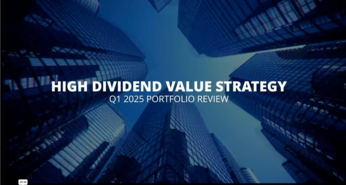Question 1: After a challenging year in 2020, how to International Dividend stocks look going forward?
The beginning of last year and when Covid first broke out was all about trying to figure out where dividend cuts might happen, and replacing that riskier income with sustainable income streams, in a really uncertain time – so we think we did a reasonably good job of that. If you look, we weren’t immune to what was happening but, if you look at our average portfolio dividend growth was about -4% last year, whereas if you look at the indices, like MSCI EAFE, it was about a -25% decline and it was even worse for a lot of the dividend, or value-oriented indices. So, I think we were able to preserve the income stream pretty well. The good news was then we had a really unique opportunity to get in a lot more cyclical exposure than what we’re typically able to do during a recession; because when you fast-forward six months from March of last year, you saw your average company – and even companies that thought they were really going to be hit hard – really weren’t hit nearly as hard as they thought [they would be]. So they were able to start resuming dividends and they were still very very cheap, and we were able to get into some very interesting cyclical exposures, which have worked very well in the year-to-date.
Question 2: Relative to history, how do valuations of International companies currently compare to US
companies?
Until a couple years ago, we’ve seen International stocks trade at around a 20-25% discount compared to US stocks, and there was a reason for that. There’s no doubting that the US is kind of a better place to do business than several International markets, owing to a less-restrictive regulatory environment, a better ability to manage the workforce, greater labor mobility – so those are all factor that account for a premium in US stocks. But, currently, the discount is over 50%, so that looks hugely excessive and really points to a great opportunity for International stocks. But what’s also interesting is that some International companies, on a case-by-case basis, have actually made huge strides in focusing more on shareholder returns and managing their workforces better – just as US companies have
been doing for years. So you can make a case that those stocks should really not trade at any discount to US peers.
Question 3: What investment themes are you most excited about?
We do think we have very unique exposure to several themes within the portfolio. One is owning best-in-class,international, multinational companies that are, we think, comparable and in some cases even better than US peers. They tend to have their assets and revenues distributed globally, just like a lot of US global multinationals. But the striking difference is that they’re so cheap and they yield so much more. On average companies trade at over a 20% discount to US peers with over double the dividend yield – so that’s a great opportunity in and of itself. We also have very good, indirect emerging market exposure, particularly to the emerging market consumer, which is a great area for long-term growth through our holdings in consumer staple, health care, financial, industrial and consumer discretionary companies. Obviously, we have great dividend attributes, so our income attributes are really attractive relative to alternatives in terms of the level of the yield and the potential for growth. We own a lot of companies that have a lot of hidden asset value and restructuring catalysts, we own, for example telecom companies that have internet businesses, which appear to be severe undervalued within the group. But probably my favorite theme, and probably the biggest them at this point within the portfolio, is climate change in that we see climate change as a huge driver for earnings growth for the companies that are providing the solutions and the services and the products to address these issues. And beyond just climate change as a catalyst for earnings growth and the massive exposure we have to that, I would say we really do have a good ESG profile in the portfolio as a
whole. And while we don’t have an ESG mandate, we are, for example, ‘A’ rated by MSCI and so we know that these days it’s very important for people to feel good about the things that they’re investing in and we couldn’t think of a better portfolio for investors that have those concerns.
Question 4: What is on the horizon for International equities?
Well, you know, there certainly are a lot more catalysts for both International and Value stocks these days than what we saw, say two or three years ago, when the stocks were still cheap but maybe didn’t have the catalysts. In terms of catalysts, certainly the move we’re seeing in higher interest rates and higher inflationary trends is definitely a huge catalyst for Value and International stocks, as the Value indices and Value stocks, in general, just have a lot more exposure to companies that benefit from higher rates and inflation – whether that be financials, or commodity companies, or energy companies. International companies and indices generally have far more exposure to those sectors than US indices, which tends to be more exposed to Tech stocks and Growth stocks, which, of course, really suffer when rates go up because their valuations begin to look that much more unappealing. Other catalysts we have is certainly the Biden administration as a catalyst. Typically when we’ve had ‘Blue Waves’ in the past you’ve seen International stocks outperform the S&P 500. Some of [Biden’s] policies, whether it be infrastructure spending or more of a focus on climate change is very good for European companies that tend to be really focused on providing solutions to those sorts of issues. We’re having a very strong earnings recovery, globally, that we would expect to accelerate as vaccines rollout – that in and of itself is a big catalyst. And then the vaccines certainly have an effect – and we really saw the announcement of the vaccines as an inflection point for Value versus Growth.




